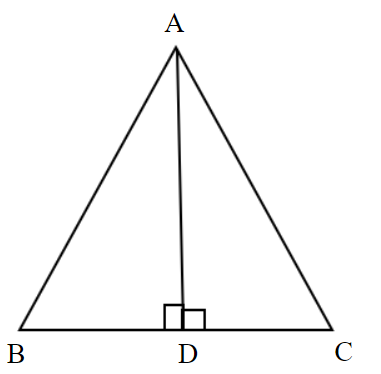
In $\Delta {\text{ABC}}$, AD is perpendicular to BC. Prove that ${\left( {{\text{AB}}} \right)^2} + {\left( {{\text{CD}}} \right)^2} = {\left( {{\text{AC}}} \right)^2} + {\left( {{\text{BD}}} \right)^2}$.


Answer
610.2k+ views
Hint- Here, we will be proceeding further with the help of Pythagoras theorem.
Clearly, from the figure we can see that there are total two right angled triangles $\Delta {\text{ABD}}$ and $\Delta {\text{ACD}}$.
As we know that the side opposite to the right angle in any right angled triangle is hypotenuse, the side opposite to the considered acute angle is perpendicular and the remaining side is base.
In right angled $\Delta {\text{ABD}}$, AB is a hypotenuse and in $\Delta {\text{ACD}}$, AC is a hypotenuse.
According to Pythagoras theorem, we know that
${\left( {{\text{Hypotenuse}}} \right)^2} = {\left( {{\text{Perpendicular}}} \right)^2} + {\left( {{\text{Base}}} \right)^2}$
Therefore, in right angled $\Delta {\text{ABD}}$, ${\left( {{\text{AB}}} \right)^2} = {\left( {{\text{AD}}} \right)^2} + {\left( {{\text{BD}}} \right)^2}{\text{ }} \to {\text{(1)}}$
and in right angled $\Delta {\text{ACD}}$, ${\left( {{\text{AC}}} \right)^2} = {\left( {{\text{AD}}} \right)^2} + {\left( {{\text{CD}}} \right)^2} \Rightarrow {\left( {{\text{AD}}} \right)^2} = {\left( {{\text{AC}}} \right)^2} - {\left( {{\text{CD}}} \right)^2}{\text{ }} \to {\text{(2)}}$
Using equation (2) in equation (1), we get
${\left( {{\text{AB}}} \right)^2} = {\left( {{\text{AC}}} \right)^2} - {\left( {{\text{CD}}} \right)^2} + {\left( {{\text{BD}}} \right)^2} \Rightarrow {\left( {{\text{AB}}} \right)^2} + {\left( {{\text{CD}}} \right)^2} = {\left( {{\text{AC}}} \right)^2} + {\left( {{\text{BD}}} \right)^2}$
The above equation is what we needed to prove.
Note- In these types of problems, Pythagora's theorem is to be used keeping in mind the concept of a right triangle i.e., which side is to be taken hypotenuse. Also, in the above problem the choice between perpendicular and base is flexible since that choice depends upon the acute angle considered.
Clearly, from the figure we can see that there are total two right angled triangles $\Delta {\text{ABD}}$ and $\Delta {\text{ACD}}$.
As we know that the side opposite to the right angle in any right angled triangle is hypotenuse, the side opposite to the considered acute angle is perpendicular and the remaining side is base.
In right angled $\Delta {\text{ABD}}$, AB is a hypotenuse and in $\Delta {\text{ACD}}$, AC is a hypotenuse.
According to Pythagoras theorem, we know that
${\left( {{\text{Hypotenuse}}} \right)^2} = {\left( {{\text{Perpendicular}}} \right)^2} + {\left( {{\text{Base}}} \right)^2}$
Therefore, in right angled $\Delta {\text{ABD}}$, ${\left( {{\text{AB}}} \right)^2} = {\left( {{\text{AD}}} \right)^2} + {\left( {{\text{BD}}} \right)^2}{\text{ }} \to {\text{(1)}}$
and in right angled $\Delta {\text{ACD}}$, ${\left( {{\text{AC}}} \right)^2} = {\left( {{\text{AD}}} \right)^2} + {\left( {{\text{CD}}} \right)^2} \Rightarrow {\left( {{\text{AD}}} \right)^2} = {\left( {{\text{AC}}} \right)^2} - {\left( {{\text{CD}}} \right)^2}{\text{ }} \to {\text{(2)}}$
Using equation (2) in equation (1), we get
${\left( {{\text{AB}}} \right)^2} = {\left( {{\text{AC}}} \right)^2} - {\left( {{\text{CD}}} \right)^2} + {\left( {{\text{BD}}} \right)^2} \Rightarrow {\left( {{\text{AB}}} \right)^2} + {\left( {{\text{CD}}} \right)^2} = {\left( {{\text{AC}}} \right)^2} + {\left( {{\text{BD}}} \right)^2}$
The above equation is what we needed to prove.
Note- In these types of problems, Pythagora's theorem is to be used keeping in mind the concept of a right triangle i.e., which side is to be taken hypotenuse. Also, in the above problem the choice between perpendicular and base is flexible since that choice depends upon the acute angle considered.
Recently Updated Pages
Master Class 10 General Knowledge: Engaging Questions & Answers for Success

Master Class 10 Computer Science: Engaging Questions & Answers for Success

Master Class 10 English: Engaging Questions & Answers for Success

Master Class 10 Social Science: Engaging Questions & Answers for Success

Master Class 10 Maths: Engaging Questions & Answers for Success

Master Class 10 Science: Engaging Questions & Answers for Success

Trending doubts
The shortest day of the year in India

Why is there a time difference of about 5 hours between class 10 social science CBSE

Write a letter to the principal requesting him to grant class 10 english CBSE

What is the median of the first 10 natural numbers class 10 maths CBSE

The Equation xxx + 2 is Satisfied when x is Equal to Class 10 Maths

Which of the following does not have a fundamental class 10 physics CBSE




